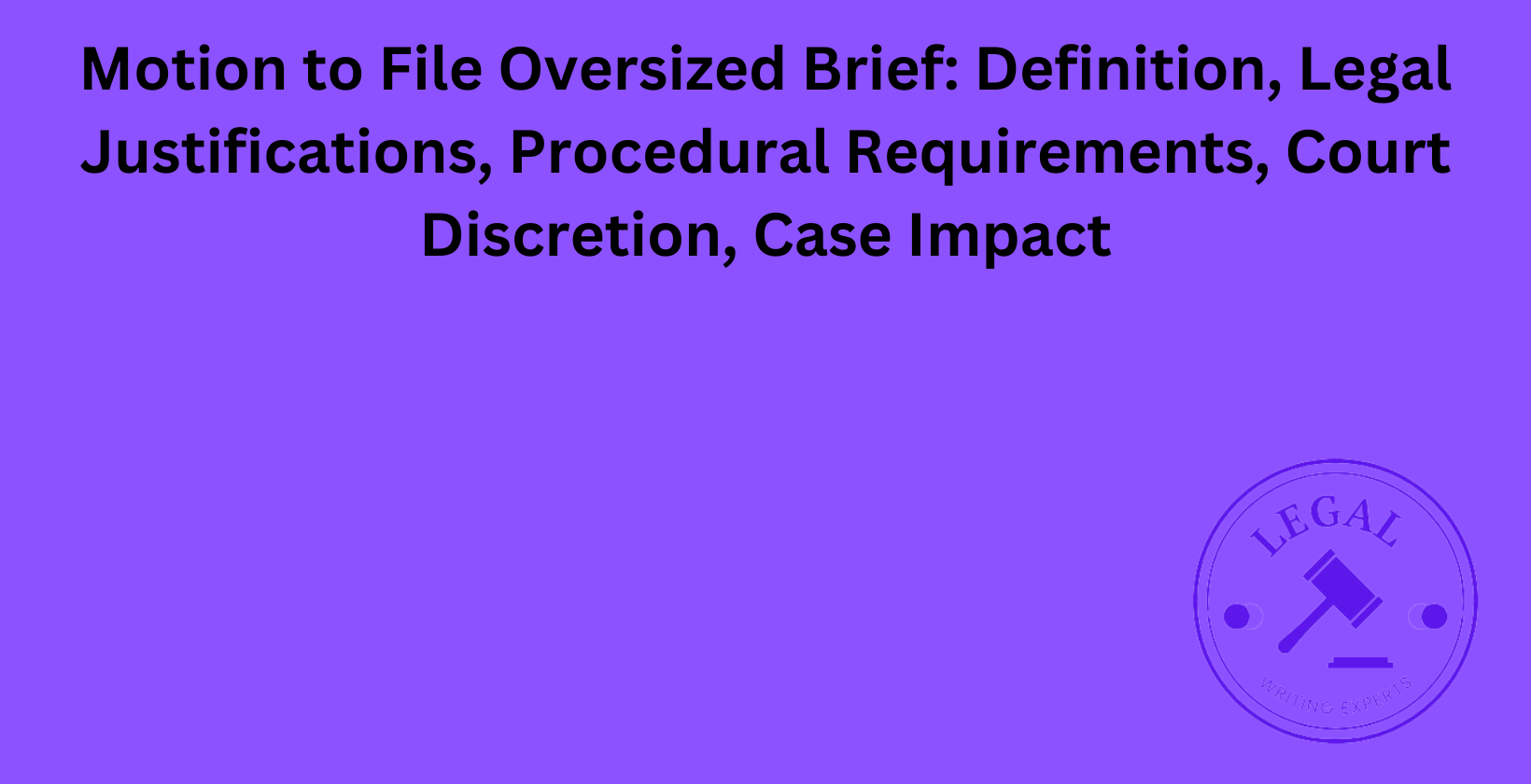Motion to File Oversized Brief
Written by
Jessica E
October 22, 2024 · 8 min read

A motion to file an oversized brief is a legal request made to the court seeking permission to exceed the standard page or word limit for a legal document. This article explores the definition, process, justifications, and implications of filing such a motion. We’ll delve into the procedural requirements, court discretion, potential impacts on case outcomes, and common mistakes to avoid. Understanding these aspects is crucial for legal professionals who may need to file oversized briefs in complex cases.
What Is a Motion to File an Oversized Brief?
A motion to file an oversized brief is a formal request submitted to the court seeking permission to exceed the standard page or word limit set for legal briefs. This type of motion is typically filed when attorneys believe that the complexity or scope of the case requires additional space to adequately present their arguments. The motion explains why the standard limits are insufficient and how the additional length will benefit the court’s understanding of the case.
How to Write a Motion to File an Oversized Brief?
Writing a motion to file an oversized brief requires careful consideration and persuasive argumentation. The motion should begin with a clear statement of the request, followed by a concise explanation of why the additional length is necessary. Include specific reasons such as the complexity of legal issues, the number of parties involved, or the volume of relevant evidence. Provide a proposed page or word count for the oversized brief. Cite relevant court rules or precedents that allow for such motions. Conclude with a respectful request for the court’s permission to file the oversized brief.
Where to Hire a Legal Writer to Draft a Motion to File an Oversized Brief?
Legal writers experienced in drafting motions to file oversized briefs can be found through Legal Writing Experts channel. Legal Writing Experts is an online platform specializing in legal writing services that offer access to freelance legal writers. Legal Writing Experts have in-house legal writers or connections to freelance professionals who provide writing services for complex legal documents. When hiring, look for writers with experience in the specific area of law and familiarity with local court rules.
How to File a Motion to File an Oversized Brief?
Filing a motion to file an oversized brief involves several steps. First, prepare the motion document according to local court rules, including proper formatting and citation. Next, file the motion with the court clerk, either electronically or in person, depending on the court’s procedures. Serve copies of the motion to all parties involved in the case. Pay any required filing fees. File a proof of service with the court to confirm that all parties received the motion. Wait for the court’s decision on the motion before proceeding with filing the actual oversized brief.
What Are the Legal Justifications for Filing an Oversized Brief?
Legal justifications for filing an oversized brief typically revolve around the complexity and importance of the case. The complexity of legal issues involved in the case may require more extensive explanation and analysis. Multiple parties or a large number of issues may necessitate additional space to address all arguments adequately. Significant public interest in the case outcome might justify a more comprehensive brief. Novel legal questions or issues of first impression may require more extensive discussion of legal principles and precedents. The presence of a voluminous record or complex factual background could justify the need for additional pages to provide necessary context.
What Procedural Requirements Are Necessary for Filing an Oversized Brief?
Procedural requirements for filing an oversized brief vary by jurisdiction but generally include several key elements. File a motion requesting permission to exceed the page or word limit well in advance of the brief’s due date. Provide a specific proposed length for the oversized brief. Include a detailed explanation of why the additional length is necessary. Comply with local court rules regarding formatting, citation, and filing procedures. Serve the motion on all parties involved in the case. Obtain the court’s permission before filing the actual oversized brief. Some courts may require the filing of a redacted version of the brief that complies with standard limits in addition to the full oversized version.
How Does Court Discretion Affect the Acceptance of an Oversized Brief?
Court discretion plays a significant role in the acceptance of an oversized brief. Judges have the authority to grant or deny motions to file oversized briefs based on their assessment of the case’s needs. Courts consider factors such as the complexity of the issues, the potential impact on judicial efficiency, and the persuasiveness of the justifications provided in the motion. Some judges may be more inclined to grant such motions in cases involving novel legal questions or significant public interest. Courts may impose conditions on the acceptance of oversized briefs, such as requiring a table of contents or limiting the extension to a specific number of additional pages.
What Happens If the Court Denies a Motion for an Oversized Brief?
The court’s denial of a motion for an oversized brief requires the filing party to adhere to the standard page or word limits. The party must revise and condense their arguments to fit within the prescribed limits. This may involve prioritizing the most crucial points and eliminating less essential details. In some cases, the party may choose to file a motion for reconsideration, providing additional justifications for the need for an oversized brief. Alternatively, they might explore other options such as filing supplementary documents or requesting oral arguments to present additional information.
What Are Common Mistakes When Filing an Oversized Brief?
Common mistakes when filing an oversized brief include failing to provide compelling justifications for the additional length. Submitting the motion too close to the brief’s due date may result in denial due to time constraints. Exceeding the proposed length stated in the motion can lead to rejection of the brief. Neglecting to follow proper formatting and citation requirements may result in the court refusing to consider the brief. Failing to serve all parties with the motion and brief can cause procedural issues. Overlooking local court rules specific to oversized briefs may lead to rejection. Including irrelevant or repetitive information in the brief, even if permission is granted, can negatively impact the court’s reception of the arguments.
How Can Filing an Oversized Brief Impact the Outcome of a Case?
Filing an oversized brief can potentially impact the outcome of a case in several ways. It allows for a more comprehensive presentation of complex legal arguments, potentially increasing the persuasiveness of the brief. The additional space may enable the inclusion of more supporting evidence and case law, strengthening the overall argument. However, an overly long brief might risk losing the court’s attention or obscuring key points. The acceptance of an oversized brief may demonstrate to the court the complexity and importance of the case, potentially leading to more thorough consideration. Conversely, if poorly executed, an oversized brief could negatively impact the court’s perception of the filing party’s ability to present concise and focused arguments.
What Is the Maximum Word or Page Limit for Standard Briefs and How Can You Exceed It?
The maximum word or page limit for standard briefs varies by jurisdiction and type of court. In federal appellate courts, the typical limit is 13,000 words or 30 pages for principal briefs. State courts may have different limits, often ranging from 25 to 50 pages. To exceed these limits, file a motion to file an oversized brief well in advance of the due date. Clearly state the proposed length and provide compelling reasons for the extension. Some courts may allow a certain percentage over the limit without a motion, while others require permission for any excess. Local court rules should be consulted for specific guidelines on exceeding standard limits.
When Should You Consider Filing an Oversized Brief Due to Complexity of Issues?
Consider filing an oversized brief due to complexity of issues when the case involves multiple intricate legal questions that cannot be adequately addressed within standard limits. Cases with extensive factual backgrounds or technical details that require in-depth explanation may justify an oversized brief. When dealing with novel legal theories or issues of first impression that necessitate comprehensive analysis of legal principles and precedents, additional length may be necessary. Cases involving multiple parties with diverse interests or a large number of disputed issues might require extra space to address all relevant arguments. High-stakes litigation with significant potential impact on legal precedent or public policy may warrant a more detailed brief.
What Role Does Timing Play in Filing an Oversized Brief?
Timing plays a crucial role in filing an oversized brief. File the motion requesting permission for an oversized brief well in advance of the brief’s due date, typically at least 7-14 days prior, depending on local rules. This allows the court sufficient time to consider the request and for the filing party to adjust if the motion is denied. Submitting the motion too close to the deadline may result in automatic denial. Some courts have specific deadlines for filing such motions, which must be strictly adhered to. The timing of the motion may affect the court’s perception of its necessity and the filing party’s preparedness.
What Are the Standards for Granting Leave to File an Oversized Brief?
The standards for granting leave to file an oversized brief vary by jurisdiction but generally involve several key factors. Courts consider the complexity and novelty of the legal issues presented in the case. The number of parties involved and the diversity of interests represented may influence the decision. The potential impact of the case on legal precedent or public policy can be a significant factor. Courts assess the persuasiveness of the justifications provided in the motion, looking for specific reasons why standard limits are inadequate. The reputation and track record of the attorney or firm filing the motion may be considered. Some courts may be more inclined to grant such motions in cases of significant public interest or those involving constitutional questions.
Meet the Author
Distinguished linguist at Legal Writing Experts
Jessica is an expert legal writer with a remarkable blend of legal knowledge and linguistic precision. She earned her Juris Doctor degree from Duke University, where she attended on a prestigious Law Faculty Merit Scholarship. At Duke, Jessica demonstrated her exceptional abilities by serving as an editor of the Duke Law Review.
After graduating, Jessica further refined her skills during a two-year appellate clerkship at a distinguished law firm in North Carolina. Throughout law school, she enhanced her research and writing expertise as a research assistant and writer for various legal firms. Jessica’s deep understanding of legal language and meticulous attention to detail make her an invaluable asset to our legal writing services.


